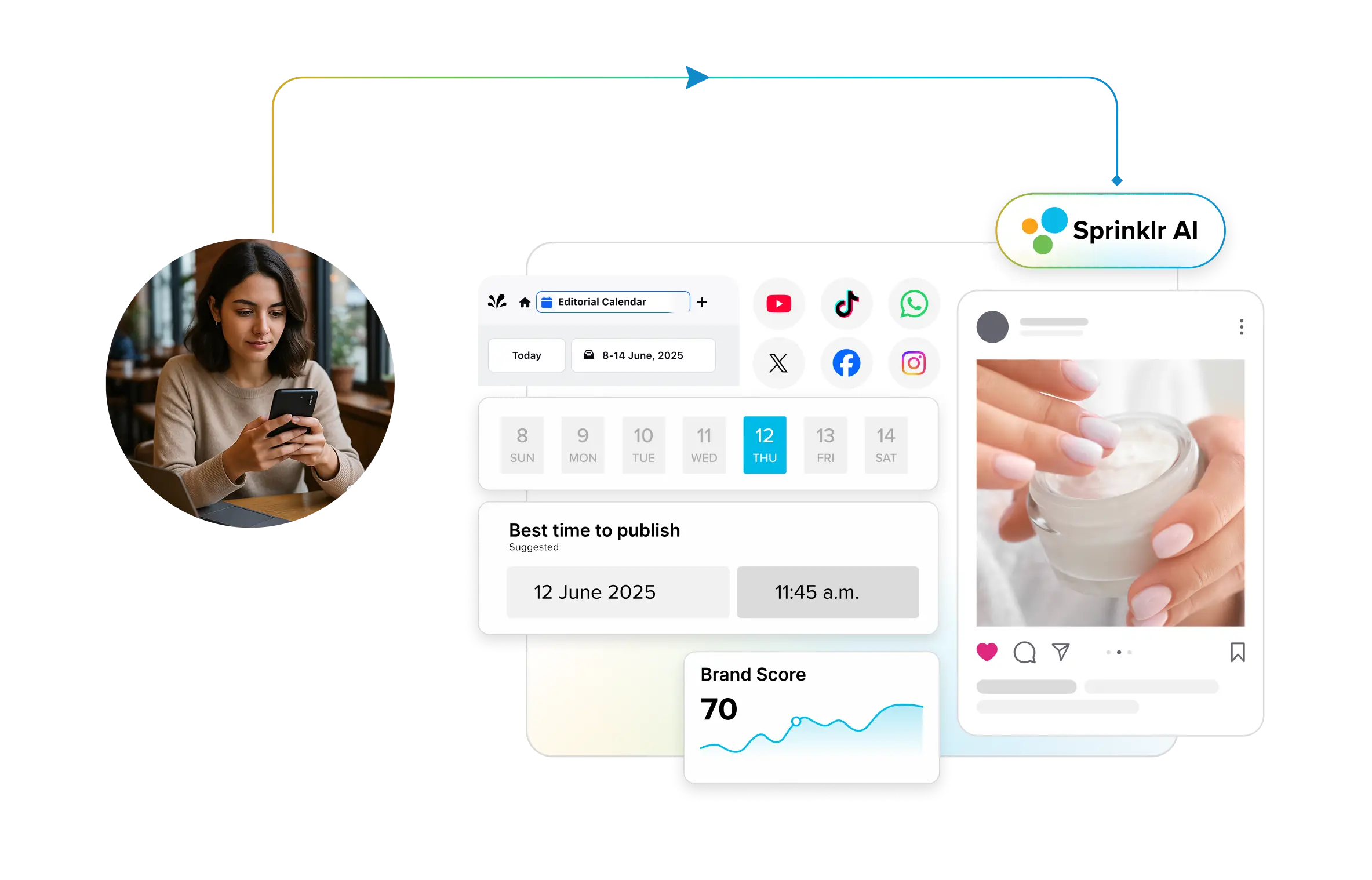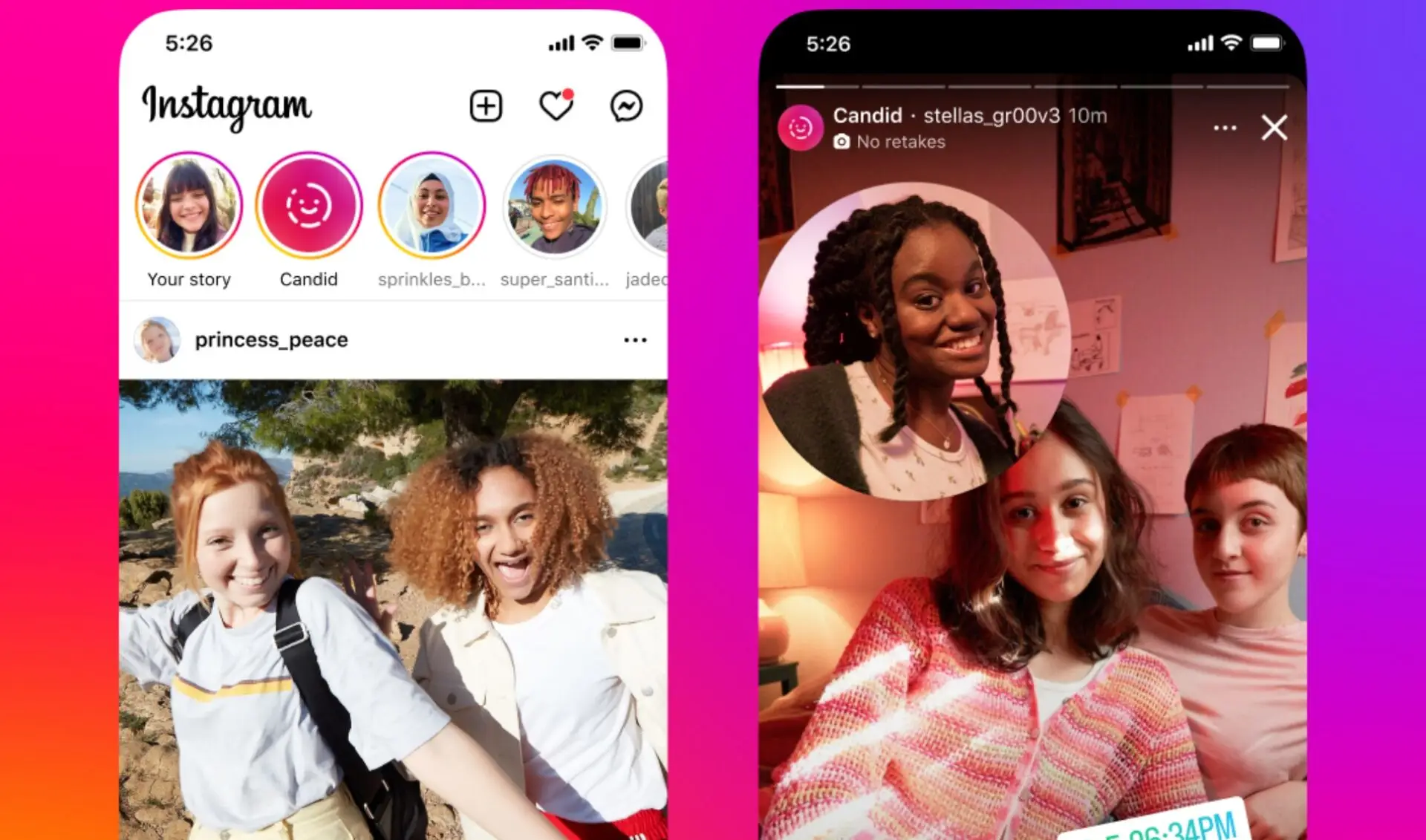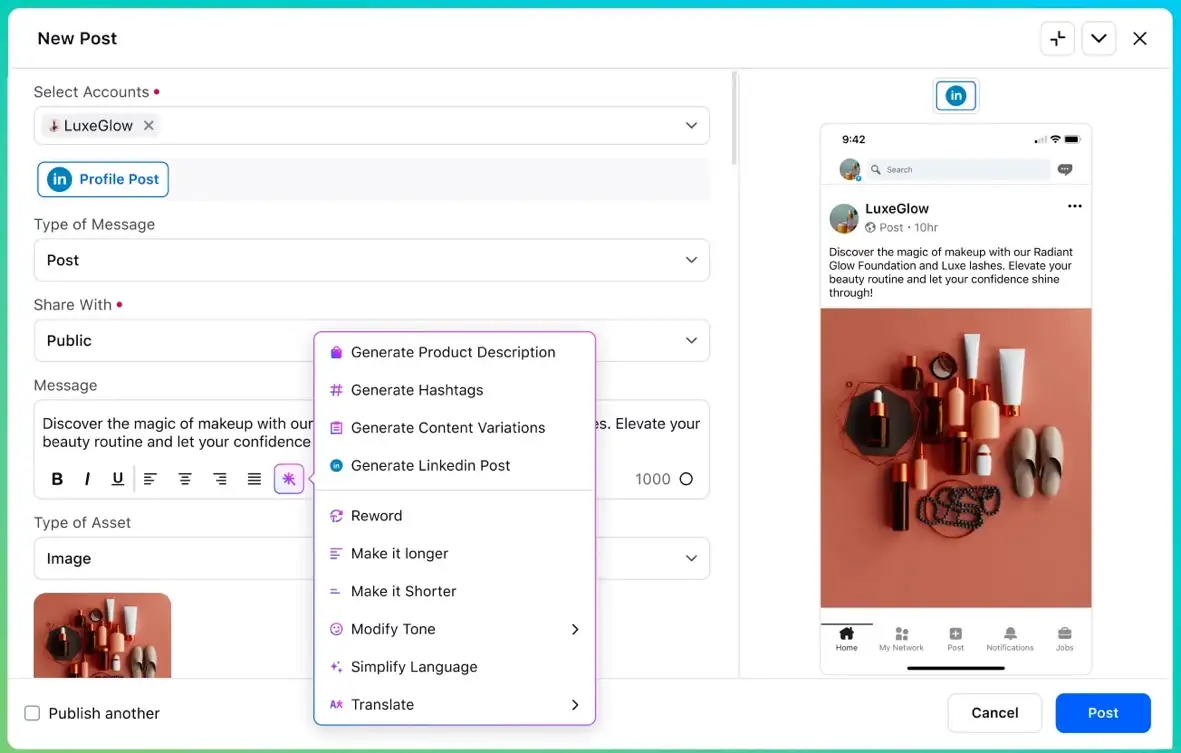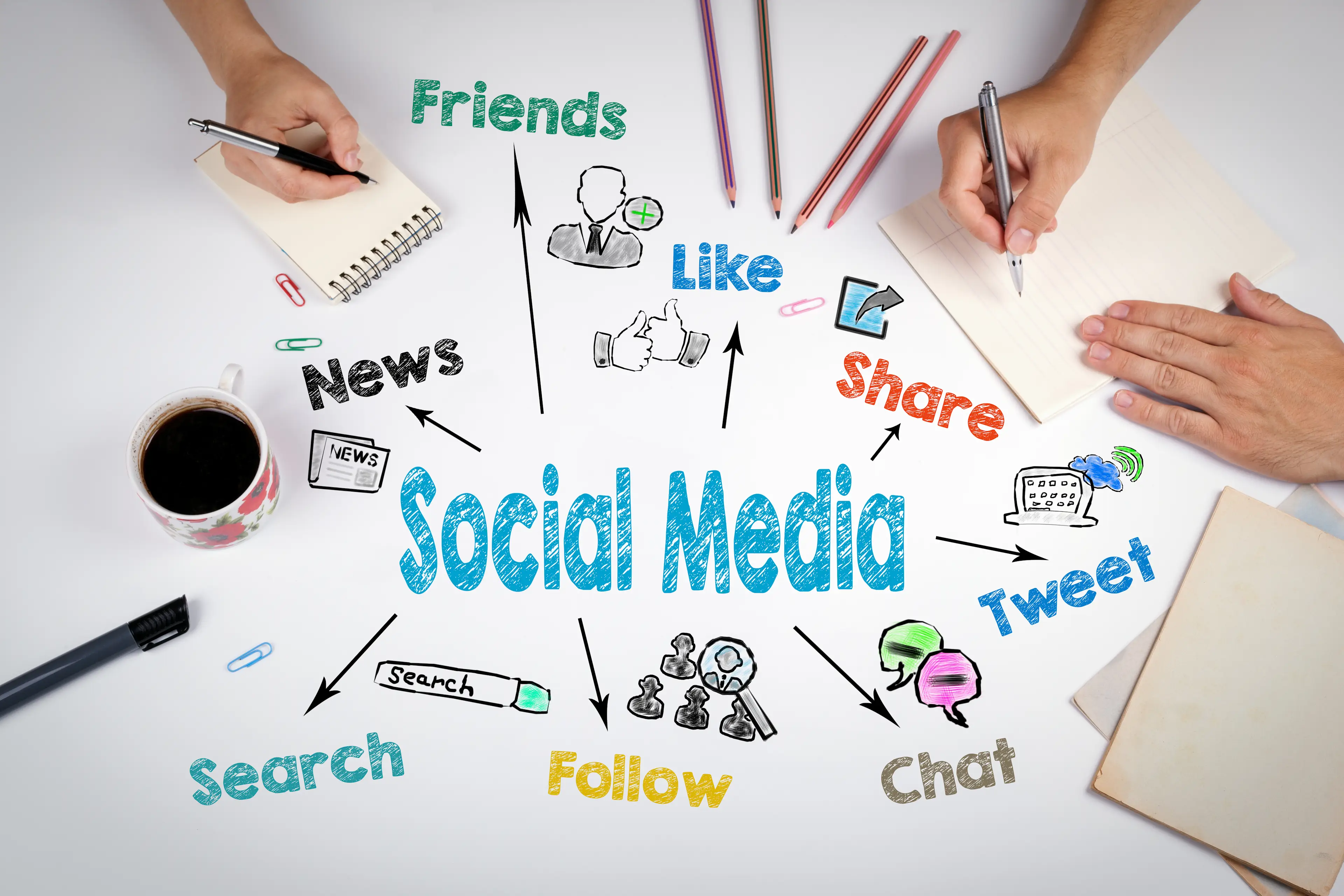The global leader in enterprise social media management
For over a decade, Sprinklr Social has helped the world’s biggest brands reimagine social media as a growth driver with a unified platform, industry-leading AI and enterprise-grade scale.

Social Media Content Strategy for Each Platform
If you aspire for social media success, invest in building a data-led, platform-specific solid social media strategy. A custom content strategy renders an unbeatable competitive advantage as testified by experts. Econsultancy reports that 67% of marketers with a custom content strategy for every platform saw an improvement in ROI. Likewise, Facebook Business says ads tailored to Facebook’s user behavior and content style witnessed 3x more click-through rates than generic, cross-platform ads.
Conversely, brands without platform-centric content strategies should prepare for failure. Your content might fail to reach or engage target audiences, dilute your brand hard-earned identity or equity, or fail to drive intended outcomes.
In this article, we help you build effective social media content plans for platforms like Facebook, Instagram, and TikTok, with practical examples, resources and tips. With our insights, you can make your brand shine on your preferred platforms with content that cuts through the noise, every time.
What is social media content strategy?
A social media content strategy is a systematic framework that governs your content creation and distribution on social media, helping you achieve social media goals efficiently. Its main components include:
- Audience analysis
- Content creation
- Platform strategy and optimization
- Competitor analysis
- Engagement strategy
- Scheduling and publishing
- Analytics
- Budget allocation
A well-crafted social media content plan helps build content and campaigns that meet audience expectations, platform specifications, and market trends, garnering engagement on crowded social platforms. It also ensures your activities on social media are aligned with broader organizational goals and brand values. Additionally, it simplifies decision making and drives improvement based on outcomes.
Why should you have a social media content plan?
A social media content plan outlines a stepwise strategy to drive organic growth on cluttered platforms via owned, earned, and paid content. It removes the guesswork from content creation and targeting, giving an assured return on investment (ROI). Besides, there are many other benefits of basing social media marketing on a data-led plan. Here are some of them:
1. Consistency and brand recognition
A watertight social media content strategy ensures your brand voice, perception, and messaging are consistent across platforms.
This consistency reflects your brand's core value and mission, helping you stand out in a competitive market, and resonate with audiences that you’d want to attract.
As a result, there's more trust and credibility which are key purchase drivers for 81% of consumers.
For instance, Coca-Cola’s iconic red and white logo paired with messages emphasizing togetherness, family, and friendship makes the brand recognizable instantly.
2. Targeted content
Social content strategy starts with audience research. You gain clarity about your target audience, their interests, preferred content formats and platforms - insights which help tailor your content.
For instance, if you are a beauty brand with two target audiences.
- Teenage girls/young adults: You'd post videos on Instagram and TikTok on trending makeup tutorials or hacks.
- Adults 30+: You'd share in-depth content on Facebook or YouTube regarding skincare tips or informative videos focusing on anti-aging.
This targeted and tailored content helps capture the right attention, drive conversion, and build a dedicated customer base. It then creates powerful connections, fostering trust and brand loyalty.
3. Efficient use of resources
A structured plan ensures you spend your time and budget on high-impact content. This benefits you with:
- Cost reduction: Selecting the right channels and best posting times for different channels helps avoid unnecessary spending on less relevant platforms.
- ROI optimization: Identifying which influencers and collaborations are worth continuing, amending, or discontinuing based on metrics helps optimize social media ROI.
- Strategic resource allocation: Reallocating resources towards marketing activities, formats, tools, and integrations that perform well.
4. Performance tracking and improvement
A social media content strategy not only guides goal setting but also allows you to assess whether or not yoursocial media goals are met. You can measure the output of your strategy by tracking relevant metrics like user interaction, sentiment, and conversion rates. Frequent analysis drives data-driven decisions and allows you to refine or optimize your content as needed.
Freebie: The State of Social Media Report [Latest Research]
In our latest State of Social Media report, commissioned with Kantar Profiles, we reveal how leading brands are adapting to dynamic platform algorithms and consumer habits.
The report will equip you with the following insights to navigate the future of social media like an expert:
- AI-powered customer engagement
- Global challenges and opportunities
- The power of social listening
- Global and regional insights
- Overcoming AI-related security concerns
CTA button: Download the full report
How to create a social media content strategy
Creating an effective content strategy demands in-depth research, countless trials and errors, and carefully considered content plans. There is also no one-size-fits-all approach.
Strategies vary based on industry, product, target demographics, and more.
Here are a few foundational steps that can and should be applied universally to build an effective, platform-optimized social content strategy.
1. Find your audience’s interests
“Know your audience” is a timeless wisdom but we cannot deny that it's crucial in guiding everything from product strategy to social content strategy. With deep audience insights, you don't just guess but deliver exactly what your audience wants.
To build detailed audience profiles, start by collecting reliable data from digital and social touchpoints used by your target audience. Here are some ways to go about data gathering:
- Google Analytics: Gives an overview report of your audience’s demographic, such as location, age, gender, interest, and language.
- Native social media platform analytics: Like Facebook Page Insights and Instagram Insights decode the audience's behavior
- Engagement patterns: The times when your audience is most active and engaged with your content
- Content preferences: The content formats that resonate with your audience
- Qualitative research: Analysis of reviews, feedback, surveys, interviews, and onboarding FAQs, is another source of audience insights.
- Social listening: It helps you track real-time conversations happening online, such as:
- Brand mentions: How customers perceive your brand
- Competitors: What are their activities and mentions
- Keywords: What conversations are happening around your industry, products, and services
Take a cue from Sephora. The beauty brand uses social listening on platforms like Instagram and TikTok to understand its audience better. It has an active social community where members discuss beauty products, share reviews, and exchange ideas. Sephora monitors and analyzes relevant mentions and uses the intel to shape its content strategy.
Go beyond basic social listening with Sprinklr
Sprinklr's AI-powered social listening gathers all information relevant to your brand and provides real-time customer insights.
These insights, based on customers' sentiments, preferences, and demographics, help you understand your audience better.
Hence, you'll be able to create social content accordingly. Further, it allows easy comparison of your social performance with your competitors at ease.

Deep audience analysis will result in a detailed audience profile or buyer persona which will be the foundation of the subsequent steps.
2. Tie business goals with audience goals
Setting goals for social media content gives you a sense of purpose and direction. It motivates your team and fosters commitment. Other than that, goal setting helps with:
- Smart budget distribution
- Systemizing and simplifying your workflow
- Coordinating your social media efforts with your marketing priorities
A common question: How to set effective goals for your social media content?
Define your marketing goals first and then tailor your social media content strategy to support them. For instance, if your marketing goal is to boost audience engagement and retention, your content strategy would be:
Publishing success stories and interactive content like polls, Q&As, or customer appreciation posts.
1. Make sure your goals follow the SMART framework.
- Specific: Be clear about what you want to achieve
- Measurable: Set trackable goals
- Achievable: Set realistic goals that are achievable with allocated resources
- Relevant: Your goal should support your overall business goal
- Time-bound: Have a specific deadline or timeframe.
2. Identify key social media metrics and KPIs that measure your goal attainment, such as engagement, retention, and traffic.
3. Assess demographics of platforms
Choosing the right social media platform is another crucial factor that determines the success of your social media content strategy.
- It helps you reach the right audience in the right way.
- You can allocate resources to channels that provide higher ROI.
- It allows authentic and consistent communication.
The strategic harmony enhances your content impact and engagement value, thereby driving strong relationships.
However, with so many social networks out there, choosing the right one can be a daunting task. So here's what you should keep in mind while selecting the ideal platform for your brand.
- Study the target audience’s platform preferences.
- Consider your overall content goal. Some platforms are better suited for awareness or top-of-funnel initiatives, while others are ideal for conversion.
- Assess platform demographics. Study your audience and match them with the platform that fits their demographic.
For instance,
TikTok: Popular among younger audiences.
Instagram: Attracts millennials and GenZ.
LinkedIn: Preferred by professionals
- Study your competitors. Observe how they're using social media platforms. You can take the help of a competitive benchmarking tool here.
4. Plan content types
There are various types of social content, including infographics, tutorials, podcasts, blogs, and more. Each content type serves a different purpose.
And not everyone in your audience consumes content in the same way. Some may prefer written content, while others may prefer video. Planning helps you align content type with your audience, ensuring that your strategy is balanced and goal-oriented.
Considering the platforms and content suitability, choose your content type. So here are a few content types you can choose from based on your content objective.
- Educational content
Purpose: Provides value
Examples: Blog posts, infographics, tutorials.
- Engagement content
Purpose: Encourage interaction
Examples: Questionnaires, quizzes, polls, meme
- Promotional content
Purpose: Drive conversions
Example: Product videos, case studies, testimonials
- Entertaining content
Purpose: Keep the followers engaged
Example: Videos, stories, BTS
- Informative
Purpose: Educate followers about your brand
Example: News updates, announcements, industry insights.
👉 To save time and costs, it’s a great idea to repurpose your content for social media. Convert your best-performing website and offline content into social posts and extract maximum mileage from it.
Read more: Best Content Tools for Social Media Content Creation
5. Schedule posts in advance
Scheduling social content means maintaining a weekly, monthly or quarterly content calendar to plan publishing across target social channels.
But why schedule a post?
- Scheduling ensures your post appears when your audience is most active.
- It avoids hasty posting because you have enough time to strategize.
- There's always flexibility to tweak your schedule based onsocial trends.
- You can bulk post at a time to save time and resources.
- The post will go live regardless of the audience's local time zone.
For smart scheduling, here are some points to consider:
Build a social media content calendar. It helps you plan and avoid duplication, gaps, and inconsistency in your post-scheduling.
Optimize your posting time based on your niche, location, platform, and audience. Analytics tools such as Facebook Insights, Twitter Analytics, or Instagram Insights come in handy to know about your audience’s busy hours online.
Consider bringing variation in your content to prevent repetition and monotony. You can always use a mix of content types like images, GIFs, videos, infographics, and more to appeal to the different preferences, moods, and learning styles of your audience.
6. A/B test and track results
Now the final step for an effective social media content strategy is to reflect on your goal.
Whether your goal was to boost engagement or drive conversation, collect data from your social analytics tool and compare it with your goal.
Or you can also use social media A/B testing techniques for decision-making. Here you compare the two strategies and determine which performs better.
For instance:
- If your social media goal is to boost your engagement rate, you might post fun behind-the-scenes photos and a tutorial. Over a month you notice that BTS photos have higher likes, shares, and comments. This suggests your followers enjoy a more authentic view of your brand. Moving forward, you'd post more of that content to strengthen audience connection.
- Similarly, if you’re keen to target young adults (aged 20-35) with your Facebook Reels, but insights show an older demographic engaging instead, you go back to the drawing board. This mismatch suggests that your content doesn't align with the platform choice or target audience. You can try to adjust your content tone, visuals, or messaging. Or maybe try other platforms that appeal to younger audiences.
Get a Unified dashboard to track all your platforms at once
Sprinklr’s social media analytics and reporting measure and analyze your content performance across 30+ social platforms through a unified dashboard, giving you unified insights on one window. Make decisions without hopping between windows.

Social media content strategies for Instagram, LinkedIn and Facebook
I. Instagram
With over 2 billion monthly active users, Instagram is the third most-used platform in the world. It has become a hotspot for businesses to connect with users.
People spend an average of 12 hours on this app, with62.4% of users following brands and products.
1. Optimize your Instagram bio: Make the first impression count with an optimized bio. Include a relevant logo and a compelling description of your brand. It helps the visitors recognize you and understand what you offer.
Also, include relevant keywords in your bio for better discoverability.
2. Create Instagram highlights: Pay attention to your Instagram stories and highlights because they lie just below your bio. And they are one of the first things your audience notice, so curate them carefully to attract their interest.
3. Use hashtags wisely: While you’re allowed to use 30 nhastags per post and 10 per story, we suggest you to use only targeted and niche hashtags. This defines the focus of your Instagram content and sends stronger signal to the algorithm.
At the same time, avoid generic hashtags like #love #happiness. They most likely have billions of posts, but only a few interested viewers.
Also Read: How to Use Hashtags Smartly in 2025
Expand your Instagram reach via collaborations
If you're collaborating with another brand or influencer, create content hinting at the partnership.
For instance, you could add behind-the-scenes clips, join live sessions, or even run a giveaway where both brands contribute.
This can attract both audiences and increase shared excitement.

II. Facebook
Facebook is another valuable platform for businesses. With around3 billion monthly active users, it’s highly suitable for tracking potential customers from around the world.
It supports all types of business goals: reach, engagement, targeting, and insights–all in one platform. So, here are a few social media content plans for you:
1. Leverage user-generated content like unboxing videos, product reviews, travel photos, etc., as it feels more relatable and trustworthy.
2. Create a themed content series, such as #Tip Tuesday, and #Wellness Friday. This establishes a routine, making your audience more likely to return for particular content.
3. Host Facebook live events to showcase product launches, discounts, live Q&A sessions, etc. Since Facebook algorithms prioritize them, they most likely reach a broader audience.
Quick tip: Utilize Facebook posts for interesting updates
You can use posts for time-sensitive discounts or flash sales to create a sense of urgency and FOMO.

III. LinkedIn
Your content strategy here should be something that promotes information, inspiration, and professionalism. So, if you're looking for success here, you should follow these strategies:
- Create informative yet engaging content that provides value and insights. How-to guides, case studies, leadership articles, and actionable tips are great informative content examples.
- Leverage employee advocacy to encourage your team to actively share and engage with your campaign content (blogs, industry news, and updates). By tapping into their networks, you can increase the reach and visibility of your message.
- Use LinkedIn analytics to understand the best time to post on LinkedIn, and then post consistently.
Advanced tips
- Leverage LinkedIn to promote your course with value-driven content.
- If you're selling a course, use LinkedIn to position yourself as an authority first. Offer value to create interest.
- Start by sharing free tips, insights, or snippets of your course content that address the pain points of your target customers.
- Write posts, create videos, or host webinars on the topic mentioned in your course.
- Engage with your audience and offer valuable advice to build trust and credibility.
- Once you've established your expertise, invite your network to join the course. Link a strong and clear CTA.
Importance of AI in social media content strategy
AI has taken social content planning to the next level as businesses are now able to create more personalized, data-driven content easily. Likewise, AI facilitates targeting and optimization at scale. If you’re looking for ways to AI-power your social content strategy, start here:
1. Recommend posting time
AI in social media content strategy uses machine language to go beyond basic demographics and understand complex user behavior patterns. It identifies when your audiences are most active and then recommends a suitable time for posting. Hence, ensuring your content reaches and engages well with your audience.
2. Create personalized content at scale
Creating personalized content while scaling is an uphill task. However, AI in social media addresses this problem by tracking user's browsing history and engagement patterns, to understand individual preferences. It then uses the information to create content that feels personalized for each user.
3. Stay relevant
AI plays a significant role in social media content strategy by constantly monitoring and analyzing trends across platforms. Hence, enabling brands to quickly adapt and stay relevant with trending topics, hashtags, and content formats.
4. Creative enhancement
AI-powered design tools analyze audience preferences to suggest templates, colors, and layouts that blend well with brand identity or resonate with viewers.
This helps brands maintain consistency in their visuals while keeping them fresh and engaging. Additionally, AI tools improve image quality, remove backgrounds, and enhance lighting, making it easy to achieve polished, professional visuals.
Read more: Create social media content with best AI tools
Ready to take your social media content to greater heights?
Sprinklr's AI+ integrates GenAI, Google Cloud’s Vertex AI, and Open AI’s GPT models to transform social media content strategy.
How it works:
- This all-in-one GenAI-enriched platform allows effortless ideation, creation, and optimization of content across various channels.
- It helps generate campaign ideas, content briefs, full posts via AI-driven grammar and tone checks.
- By streamlining every aspect of your social media content strategy, Sprinklr ensures your brand stays ahead with timely and relevant posts.

Ready to take your social media content to greater heights? Grab a demo of Sprinklr AI+ now!
The takeaway
To summarize, a powerful social media content strategy is a must for consistent, high-quality content campaigns that align with your brand. It helps create tailored content based on audience behaviors and preferences. Further, it facilitates regular performance tracking and analysis, allowing businesses to adjust content based on key metrics like engagement and conversion rates.
Trusted by largest enterprises worldwide over the decade, Sprinklr Social empowers brands to deliver unique exceptional experiences on social media.
It allows organizations to manage social media at scale with its unmatched channel coverage, industry-leading AI, and enterprise-grade governance.
Whether you're looking to enhance engagement, build community, or elevate your brand's presence, Sprinklr Social has everything under one roof to unlock your full potential. Refine your social strategy with Sprinklr Social today!










